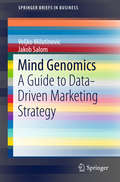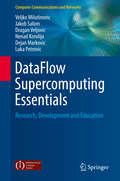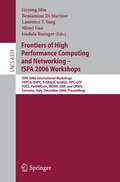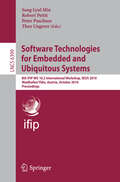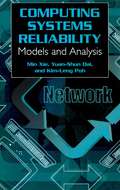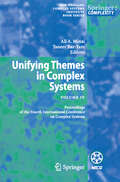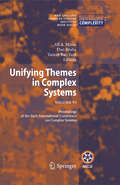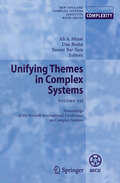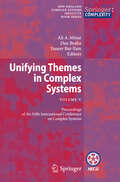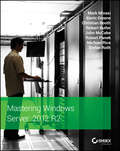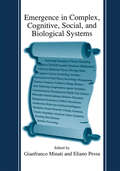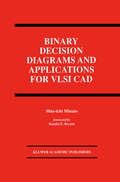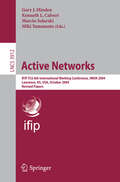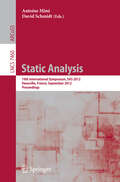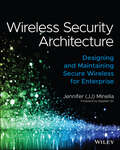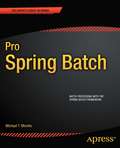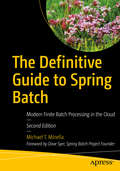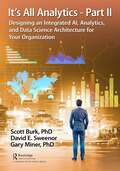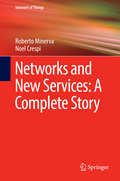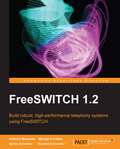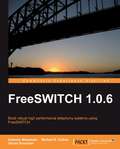- Table View
- List View
Mind Genomics: A Guide to Data-Driven Marketing Strategy (SpringerBriefs in Business)
by Veljko Milutinovic Jakob SalomIn this book, the authors describe how Mind Genomics works - a revolutionary marketing method that combines the three sciences of Mathematics, Psychology, and Economics - in a masterful way. Mind Genomics helps the seller of products and services to know what people are thinking about them before one ever commits to an approach by knowing what is important to the people one is trying to influence. Mind Genomics identifies what aspects of a general topic are important to the audience, how different people in the audience will respond to different aspects of that topic, and how to pinpoint the viewpoints of different audience segments to each aspect of the topic.A careful step by step approach explains what activities ought to be taken and what scenarios must be followed while applying this method in order to find the right way to capture the hearts and minds of targeted audiences. This book explains how Mind Genomics plays a matching game with one’s potential audience and various ways one can present the products and ideas resulting in a systematic approach to influencing others, backed by real data; how one can play with ideas, see patterns imposed by the mind and create new, inductive, applied sciences of the mind, measuring the world using the mind of man as the yardstick. In details it describes how everyday thought is transferred into actionable data and results.Whether one is a senior marketer for a large corporation, a professor at a university, or administrator at a hospital, one could use Mind Genomics to learn how to transform available information into actionable steps that will increase the products sales, or increase the number of interested students for a new university program, or the number of satisfied patients in the hospital with their medical conditions kept at highest levels after leaving it. Mind Genomics was first introduced by Dr. Howard Moskowitz, an alumnus of Harvard University and the father of Horizontal Segmentation - a widely accepted business model for targeted marketing and profit maximization.
DataFlow Supercomputing Essentials: Research, Development and Education (Computer Communications and Networks)
by Veljko Milutinovic Jakob Salom Dragan Veljovic Nenad Korolija Dejan Markovic Luka PetrovicThis informative text/reference highlights the potential of DataFlow computing in research requiring high speeds, low power requirements, and high precision, while also benefiting from a reduction in the size of the equipment. The cutting-edge research and implementation case studies provided in this book will help the reader to develop their practical understanding of the advantages and unique features of this methodology.This work serves as a companion title to DataFlow Supercomputing Essentials: Algorithms, Applications and Implementations, which reviews the key algorithms in this area, and provides useful examples.Topics and features: reviews the library of tools, applications, and source code available to support DataFlow programming; discusses the enhancements to DataFlow computing yielded by small hardware changes, different compilation techniques, debugging, and optimizing tools; examines when a DataFlow architecture is best applied, and for which types of calculation; describes how converting applications to a DataFlow representation can result in an acceleration in performance, while reducing the power consumption; explains how to implement a DataFlow application on Maxeler hardware architecture, with links to a video tutorial series available online. This enlightening volume will be of great interest to all researchers investigating supercomputing in general, and DataFlow computing in particular. Advanced undergraduate and graduate students involved in courses on Data Mining, Microprocessor Systems, and VLSI Systems, will also find the book to be a helpful reference.
Frontiers of High Performance Computing and Networking – ISPA 2006 Workshops: ISPA 2006 International Workshops FHPCN, XHPC, S-GRACE, GridGIS, HPC-GTP, PDCE, ParDMCom, WOMP, ISDF, and UPWN, Sorrento, Italy, December 4 -7, 2006, Proceedings (Lecture Notes in Computer Science #4331)
by Geyong Min Beniamino Di Martino Laurence T. Yang Minyi Guo Gudula RuengerThis book constitutes the refereed joint proceedings of ten international workshops held in conjunction with the 4th International Symposium on Parallel and Distributed Processing and Applications, ISPA 2006, held in Sorrento, Italy in December 2006. It contains 116 papers that contribute to enlarging the spectrum of the more general topics treated in the ISPA 2006 main conference.
Software Technologies for Embedded and Ubiquitous Systems: 8th IFIP WG 10.2 International Workshop, SEUS 2010, Waidhofen/Ybbs, Austria, October 13-15, 2010, Proceedings (Lecture Notes in Computer Science #6399)
by Sang Lyul Min Robert Pettit Theo UngererThe 8th IFIP Workshop on Software Technologies for Embedded and Ubiq- tous Systems (SEUS 2010) in Waidhofen/Ybbs, Austria, October 13-15, 2010, succeeded the seven previous workshops in Newport Beach, USA (2009); Capri, Italy (2008); Santorini, Greece (2007); Gyeongju, Korea (2006); Seattle, USA (2005); Vienna, Austria (2004); and Hokodate, Japan (2003); installing SEUS as a successfully established workshop in the ?eld of embedded and ubiquitous systems. SEUS 2010 continued the tradition of fostering cross-community scienti?c excellence and establishing strong links between research and industry. SEUS 2010 provided a forum where researchers and practitioners with substantial - periences and serious interests in advancing the state of the art and the state of practice in the ?eld of embedded and ubiquitous computing systems gathered with the goal of fostering new ideas, collaborations, and technologies. The c- tributions in this volume present advances in integrating the ?elds of embedded computing and ubiquitous systems. The call for papers attracted 30 submissions from all around the world. Each submission was assigned to at least four members of the Program Committee for review. The Program Committee decided to accept 21 papers, which were arranged in eight sessions. The accepted papers are from Austria, Denmark, France, Germany, Italy, Japan, Korea, Portugal, Taiwan, UK, and USA. Two keynotes complemented the strong technical program.
Computing System Reliability: Models and Analysis
by Min Xie Kim-Leng Poh Yuan-Shun DaiComputing systems are of growing importance because of their wide use in many areas including those in safety-critical systems. This book describes the basic models and approaches to the reliability analysis of such systems. An extensive review is provided and models are categorized into different types. Some Markov models are extended to the analysis of some specific computing systems such as combined software and hardware, imperfect debugging processes, failure correlation, multi-state systems, heterogeneous subsystems, etc. One of the aims of the presentation is that based on the sound analysis and simplicity of the approaches, the use of Markov models can be better implemented in the computing system reliability.
Unifying Themes in Complex Systems IV: Proceedings of the Fourth International Conference on Complex Systems
by Ali A. Minai Yaneer Bar-YamIn June of 2002, over 500 professors, students and researchers met in Boston, Massachusetts for the Fourth International Conference on Complex Systems. The attendees represented a remarkably diverse collection of fields: biology, ecology, physics, engineering, computer science, economics, psychology and sociology, The goal of the conference was to encourage cross-fertilization between the many disciplines represented and to deepen understanding of the properties common to all complex systems. This volume contains 43 papers selected from the more than 200 presented at the conference. Topics include: cellular automata, neurology, evolution, computer science, network dynamics, and urban planning. About NECSI: For over 10 years, The New England Complex Systems Institute (NECSI) has been instrumental in the development of complex systems science and its applications. NECSI conducts research, education, knowledge dissemination, and community development around the world for the promotion of the study of complex systems and its application for the betterment of society. NECSI hosts the International Conference on Complex Systems and publishes the NECSI Book Series in conjunction with Springer Publishers. ALI MINAI is an Affiliate of the New England Complex Systems Institute and an Associate Professor in the Department of Electrical and Computer Engineering and Computer Science at the University of Cincinnati. YANEER BAR-YAM is President and founder of the New England Complex Systems Institute. He is the author of Dynamics of Complex Systems and Making Things Work: Solving Complex Problems in a Complex World.
Unifying Themes in Complex Systems: Vol VI: Proceedings of the Sixth International Conference on Complex Systems
by Ali A. Minai Dan Braha Yaneer Bar-YamIn recent years, scientists have applied the principles of complex systems science to increasingly diverse fields. The results have been nothing short of remarkable: their novel approaches have provided answers to long-standing questions in biology, ecology, physics, engineering, computer science, economics, psychology and sociology. "Unifying Themes in Complex Systems" is a well established series of carefully edited conference proceedings that serve the purpose of documenting and archiving the progress of cross-fertilization in this field. About NECSI: For over 10 years, The New England Complex Systems Institute (NECSI) has been instrumental in the development of complex systems science and its applications. NECSI conducts research, education, knowledge dissemination, and community development around the world for the promotion of the study of complex systems and its application for the betterment of society. NECSI hosts the International Conference on Complex Systems and publishes the NECSI Book Series in conjunction with Springer Publishers.
Unifying Themes in Complex Systems VII: Proceedings of the Seventh International Conference on Complex Systems
by Ali A. Minai Dan Braha Yaneer Bar-YamThe International Conference on Complex Systems (ICCS) creates a unique atmosphere for scientists of all fields, engineers, physicians, executives, and a host of other professionals to explore common themes and applications of complex system science. With this new volume, Unifying Themes in Complex Systems continues to build common ground between the wide-ranging domains of complex system science.
Unifying Themes in Complex Systems , Vol. V: Proceedings of the Fifth International Conference on Complex Systems
by Ali A. Minai Dan Braha Yaneer Bar-YamThe International Conference on Complex Systems (ICCS) creates a unique atmosphere for scientists of all fields, engineers, physicians, executives, and a host of other professionals to explore common themes and applications of complex system science. With this new volume, Unifying Themes in Complex Systems continues to build common ground between the wide-ranging domains of complex system science.
Mastering Windows Server 2012 R2
by Mark Minasi Kevin Greene Christian Booth Robert Butler John McCabe Robert Panek Michael Rice Stefan RothCheck out the new Hyper-V, find new and easier ways to remotely connect back into the office, or learn all about Storage Spaces—these are just a few of the features in Windows Server 2012 R2 that are explained in this updated edition from Windows authority Mark Minasi and a team of Windows Server experts led by Kevin Greene. This book gets you up to speed on all of the new features and functions of Windows Server, and includes real-world scenarios to put them in perspective. If you're a system administrator upgrading to, migrating to, or managing Windows Server 2012 R2, find what you need to do the job in this complete resource. Learn all about: Installing or upgrading to and managing Windows Server 2012 R2 Understanding Microsoft NIC teams 2012 and PowerShell Setting up via GUI or updated Server Core 2012 Migrating, merging, and modifying your Active Directory Managing address spaces with IPAM Understanding new shared storage, storage spaces, and better tools Controlling access to file shares—a new and improved approach Using and administering Remote Desktop, Virtual Desktop, and Hyper-V®
Emergence in Complex, Cognitive, Social, and Biological Systems
by Gianfranco Minati Eliano PessaThe systems movement is made up of many systems societies as well as of disciplinary researchers and researches, explicitly or implicitly focusing on the subject of systemics, officially introduced in the scientific community fifty years ago. Many researches in different fields have been and continue to be sources of new ideas and challenges for the systems community. To this regard, a very important topic is the one of EMERGENCE. Between the goals for the actual and future systems scientists there is certainly the definition of a general theory of emergence and the building of a general model of it. The Italian Systems Society, Associazione Italiana per la Ricerca sui Sistemi (AIRS), decided to devote its Second National Conference to this subject. Because AIRS is organized under the form of a network of researchers, institutions, scholars, professionals, and teachers, its research activity has an impact at different levels and in different ways. Thus the topic of emergence was not only the focus of this conference but it is actually the main subject of many AIRS activities.
Binary Decision Diagrams and Applications for VLSI CAD (The Springer International Series in Engineering and Computer Science #342)
by Shin-ichi MinatoSymbolic Boolean manipulation using binary decision diagrams (BDDs) has been successfully applied to a wide variety of tasks, particularly in very large scale integration (VLSI) computer-aided design (CAD). The concept of decision graphs as an abstract representation of Boolean functions dates back to the early work by Lee and Akers. In the last ten years, BDDs have found widespread use as a concrete data structure for symbolic Boolean manipulation. With BDDs, functions can be constructed, manipulated, and compared by simple and efficient graph algorithms. Since Boolean functions can represent not just digital circuit functions, but also such mathematical domains as sets and relations, a wide variety of CAD problems can be solved using BDDs. `Binary Decision Diagrams and Applications for VLSI CAD provides valuable information for both those who are new to BDDs as well as to long time aficionados.' -from the Foreword by Randal E. Bryant. `Over the past ten years ... BDDs have attracted the attention of many researchers because of their suitability for representing Boolean functions. They are now widely used in many practical VLSI CAD systems. ... this book can serve as an introduction to BDD techniques and ... it presents several new ideas on BDDs and their applications. ... many computer scientists and engineers will be interested in this book since Boolean function manipulation is a fundamental technique not only in digital system design but also in exploring various problems in computer science.' - from the Preface by Shin-ichi Minato.
Social Media Marketing in Tourism and Hospitality
by Roberta MinazziThis book describes ongoing developments in social media within the tourism and hospitality sector, highlighting impacts on both the demand and the supply side. It offers a combination of theory and practice, with discussion of real-life business experiences. The book is divided into three parts, the first of which provides an overview of recent trends in social media and user-generated content, clarifies concepts that are often used in an overlapping way and examines the “digitization of word of mouth” via online networks. The second part analyzes the impacts that social media can have on traveler behavior for each step in the travel process and also on suppliers, highlighting opportunities, threats and strategies. In the third part of the book, future potential trends deriving from the mobile marketing technologies are explored and possible methods for social monitoring by means of key performance indicators are examined. It is considered how engaging customers and prospects by means of social media might increase customer loyalty, foster electronic word-of-mouth communication, and consequently have important effects on corporate sales and revenues. The discussion encompasses methods to measure company performance on each of the social media in order to understand the optimal mix that will support and improve business strategies.
Active Networks: IFIP TC6 6th International Working Conference, IWAN 2004, Lawrence, KS, USA, October 27-29, 2004, Revised Papers (Lecture Notes in Computer Science #3912)
by Gary J. MindenThis book constitutes the thoroughly refereed post-proceedings of the IFIP-TC6 6th Annual International Working Conference on Active Networks, IWAN 2004, held in Lawrence, KS, USA in October 2004. The 14 revised full papers presented together with one invited paper are organized in topical sections on active networking systems, active networking security, active networking applications, mobile active networks, and active networking management.
Static Analysis: 19th International Symposium, SAS 2012, Deauville, France, September 11-13, 2012. Proceedings (Lecture Notes in Computer Science #7460)
by Antoine Mine David SchmidtThis book constitutes the thoroughly refereed proceedings of the 19th International Symposium on Static Analysis, SAS 2012, held in Deauville, France, in September 2012. The 25 revised full papers presented together with 4 invited talks were selected from 62 submissions. The papers address all aspects of static analysis, including abstract domains, abstract interpretation, abstract testing, bug detection, data flow analysis, model checking, new applications, program transformation, program verification, security analysis, theoretical frameworks, and type checking.
Wireless Security Architecture: Designing and Maintaining Secure Wireless for Enterprise
by Jennifer MinellaReduce organizational cybersecurity risk and build comprehensive WiFi, private cellular, and IOT security solutions Wireless Security Architecture: Designing and Maintaining Secure Wireless for Enterprise offers readers an essential guide to planning, designing, and preserving secure wireless infrastructures. It is a blueprint to a resilient and compliant architecture that responds to regulatory requirements, reduces organizational risk, and conforms to industry best practices. This book emphasizes WiFi security, as well as guidance on private cellular and Internet of Things security. Readers will discover how to move beyond isolated technical certifications and vendor training and put together a coherent network that responds to contemporary security risks. It offers up-to-date coverage—including data published for the first time—of new WPA3 security, Wi-Fi 6E, zero-trust frameworks, and other emerging trends. It also includes: Concrete strategies suitable for organizations of all sizes, from large government agencies to small public and private companies Effective technical resources and real-world sample architectures Explorations of the relationships between security, wireless, and network elements Practical planning templates, guides, and real-world case studies demonstrating application of the included conceptsPerfect for network, wireless, and enterprise security architects, Wireless Security Architecture belongs in the libraries of technical leaders in firms of all sizes and in any industry seeking to build a secure wireless network.
Wireless Security Architecture: Designing and Maintaining Secure Wireless for Enterprise
by Jennifer MinellaReduce organizational cybersecurity risk and build comprehensive WiFi, private cellular, and IOT security solutions Wireless Security Architecture: Designing and Maintaining Secure Wireless for Enterprise offers readers an essential guide to planning, designing, and preserving secure wireless infrastructures. It is a blueprint to a resilient and compliant architecture that responds to regulatory requirements, reduces organizational risk, and conforms to industry best practices. This book emphasizes WiFi security, as well as guidance on private cellular and Internet of Things security. Readers will discover how to move beyond isolated technical certifications and vendor training and put together a coherent network that responds to contemporary security risks. It offers up-to-date coverage—including data published for the first time—of new WPA3 security, Wi-Fi 6E, zero-trust frameworks, and other emerging trends. It also includes: Concrete strategies suitable for organizations of all sizes, from large government agencies to small public and private companies Effective technical resources and real-world sample architectures Explorations of the relationships between security, wireless, and network elements Practical planning templates, guides, and real-world case studies demonstrating application of the included conceptsPerfect for network, wireless, and enterprise security architects, Wireless Security Architecture belongs in the libraries of technical leaders in firms of all sizes and in any industry seeking to build a secure wireless network.
Pro Spring Batch
by Michael MinellaSince its release, Spring Framework has transformed virtually every aspect of Java development including web applications, security, aspect-oriented programming, persistence, and messaging. Spring Batch, one of its newer additions, now brings the same familiar Spring idioms to batch processing. Spring Batch addresses the needs of any batch process, from the complex calculations performed in the biggest financial institutions to simple data migrations that occur with many software development projects. Pro Spring Batch is intended to answer three questions: What? What is batch processing? What does it entail? What makes it different from the other applications we are developing? What are the challenges inherent in the development of a batch process? Why? Why do batch processing? Why can’t we just process things as we get them? Why do we do batch processing differently than the web applications that we currently work on? How? How to implement a robust, scalable, distributed batch processing system using open-source frameworks Pro Spring Batch gives concrete examples of how each piece of functionality is used and why it would be used in a real-world application. This includes providing tips that the "school of hard knocks" has taught author Michael Minella during his experience with Spring Batch. Pro Spring Batch includes examples of I/O options that are not mentioned in the official user’s guide, as well as performance tips on things like how to limit the impact of maintaining the state of your jobs. The author also walks you through, from end to end, the design and implementation of a batch process based upon a theoretical real-world example. This includes basic project setup, implementation, testing, tuning and scaling for large volumes.
The Definitive Guide to Spring Batch: Modern Finite Batch Processing in the Cloud
by Michael T. MinellaWork with all aspects of batch processing in a modern Java environment using a selection of Spring frameworks. This book provides up-to-date examples using the latest configuration techniques based on Java configuration and Spring Boot. The Definitive Guide to Spring Batch takes you from the “Hello, World!” of batch processing to complex scenarios demonstrating cloud native techniques for developing batch applications to be run on modern platforms. Finally this book demonstrates how you can use areas of the Spring portfolio beyond just Spring Batch 4 to collaboratively develop mission-critical batch processes.You’ll see how a new class of use cases and platforms has evolved to have an impact on batch-processing. Data science and big data have become prominent in modern IT and the use of batch processing to orchestrate workloads has become commonplace. The Definitive Guide to Spring Batch covers how running finite tasks on cloud infrastructure in a standardized way has changed where batch applications are run.Additionally, you’ll discover how Spring Batch 4 takes advantage of Java 9, Spring Framework 5, and the new Spring Boot 2 micro-framework. After reading this book, you’ll be able to use Spring Boot to simplify the development of your own Spring projects, as well as take advantage of Spring Cloud Task and Spring Cloud Data Flow for added cloud native functionality.Includes a foreword by Dave Syer, Spring Batch project founder.What You'll LearnDiscover what is new in Spring Batch 4 Carry out finite batch processing in the cloud using the Spring Batch projectUnderstand the newest configuration techniques based on Java configuration and Spring Boot using practical examplesMaster batch processing in complex scenarios including in the cloud Develop batch applications to be run on modern platforms Use areas of the Spring portfolio beyond Spring Batch to develop mission-critical batch processesWho This Book Is ForExperienced Java and Spring coders new to the Spring Batch platform. This definitive book will be useful in allowing even experienced Spring Batch users and developers to maximize the Spring Batch tool.
It's All Analytics - Part II: Designing an Integrated AI, Analytics, and Data Science Architecture for Your Organization
by Gary Miner Scott Burk David SweenorUp to 70% and even more of corporate Analytics Efforts fail!!! Even after these corporations have made very large investments, in time, talent, and money, in developing what they thought were good data and analytics programs. Why? Because the executives and decision makers and the entire analytics team have not considered the most important aspect of making these analytics efforts successful. In this Book II of "It’s All Analytics!" series, we describe two primary things: 1) What this "most important aspect" consists of, and 2) How to get this "most important aspect" at the center of the analytics effort and thus make your analytics program successful. This Book II in the series is divided into three main parts: Part I, Organizational Design for Success, discusses ……. The need for a complete company / organizational Alignment of the entire company and its analytics team for making its analytics successful. This means attention to the culture – the company culture culture!!! To be successful, the CEO’s and Decision Makers of a company / organization must be fully cognizant of the cultural focus on ‘establishing a center of excellence in analytics’. Simply, "culture – company culture" is the most important aspect of a successful analytics program. The focus must be on innovation, as this is needed by the analytics team to develop successful algorithms that will lead to greater company efficiency and increased profits. Part II, Data Design for Success, discusses ….. Data is the cornerstone of success with analytics. You can have the best analytics algorithms and models available, but if you do not have good data, efforts will at best be mediocre if not a complete failure. This Part II also goes further into data with descriptions of things like Volatile Data Memory Storage and Non-Volatile Data Memory Storage, in addition to things like data structures and data formats, plus considering things like Cluster Computing, Data Swamps, Muddy Data, Data Marts, Enterprise Data Warehouse, Data Reservoirs, and Analytic Sandboxes, and additionally Data Virtualization, Curated Data, Purchased Data, Nascent & Future Data, Supplemental Data, Meaningful Data, GIS (Geographic Information Systems) & Geo Analytics Data, Graph Databases, and Time Series Databases. Part II also considers Data Governance including Data Integrity, Data Security, Data Consistency, Data Confidence, Data Leakage, Data Distribution, and Data Literacy. Part III, Analytics Technology Design for Success, discusses …. Analytics Maturity and aspects of this maturity, like Exploratory Data Analysis, Data Preparation, Feature Engineering, Building Models, Model Evaluation, Model Selection, and Model Deployment. Part III also goes into the nuts and bolts of modern predictive analytics, discussing such terms as AI = Artificial Intelligence, Machine Learning, Deep Learning, and the more traditional aspects of analytics that feed into modern analytics like Statistics, Forecasting, Optimization, and Simulation. Part III also goes into how to Communicate and Act upon Analytics, which includes building a successful Analytics Culture within your company / organization. All-in-all, if your company or organization needs to be successful using analytics, this book will give you the basics of what you need to know to make it happen.
It's All Analytics - Part II: Designing an Integrated AI, Analytics, and Data Science Architecture for Your Organization
by Gary Miner Scott Burk David SweenorUp to 70% and even more of corporate Analytics Efforts fail!!! Even after these corporations have made very large investments, in time, talent, and money, in developing what they thought were good data and analytics programs. Why? Because the executives and decision makers and the entire analytics team have not considered the most important aspect of making these analytics efforts successful. In this Book II of "It’s All Analytics!" series, we describe two primary things: 1) What this "most important aspect" consists of, and 2) How to get this "most important aspect" at the center of the analytics effort and thus make your analytics program successful. This Book II in the series is divided into three main parts: Part I, Organizational Design for Success, discusses ……. The need for a complete company / organizational Alignment of the entire company and its analytics team for making its analytics successful. This means attention to the culture – the company culture culture!!! To be successful, the CEO’s and Decision Makers of a company / organization must be fully cognizant of the cultural focus on ‘establishing a center of excellence in analytics’. Simply, "culture – company culture" is the most important aspect of a successful analytics program. The focus must be on innovation, as this is needed by the analytics team to develop successful algorithms that will lead to greater company efficiency and increased profits. Part II, Data Design for Success, discusses ….. Data is the cornerstone of success with analytics. You can have the best analytics algorithms and models available, but if you do not have good data, efforts will at best be mediocre if not a complete failure. This Part II also goes further into data with descriptions of things like Volatile Data Memory Storage and Non-Volatile Data Memory Storage, in addition to things like data structures and data formats, plus considering things like Cluster Computing, Data Swamps, Muddy Data, Data Marts, Enterprise Data Warehouse, Data Reservoirs, and Analytic Sandboxes, and additionally Data Virtualization, Curated Data, Purchased Data, Nascent & Future Data, Supplemental Data, Meaningful Data, GIS (Geographic Information Systems) & Geo Analytics Data, Graph Databases, and Time Series Databases. Part II also considers Data Governance including Data Integrity, Data Security, Data Consistency, Data Confidence, Data Leakage, Data Distribution, and Data Literacy. Part III, Analytics Technology Design for Success, discusses …. Analytics Maturity and aspects of this maturity, like Exploratory Data Analysis, Data Preparation, Feature Engineering, Building Models, Model Evaluation, Model Selection, and Model Deployment. Part III also goes into the nuts and bolts of modern predictive analytics, discussing such terms as AI = Artificial Intelligence, Machine Learning, Deep Learning, and the more traditional aspects of analytics that feed into modern analytics like Statistics, Forecasting, Optimization, and Simulation. Part III also goes into how to Communicate and Act upon Analytics, which includes building a successful Analytics Culture within your company / organization. All-in-all, if your company or organization needs to be successful using analytics, this book will give you the basics of what you need to know to make it happen.
Networks and New Services: A Complete Story (Internet of Things)
by Roberto Minerva Noel CrespiThis book shines a spotlight on software-centric networks and their emerging service environments. The authors examine the road ahead for connectivity, for both humans and 'things', considering the rapid changes that have shaken the industry. The book analyses major catalytic shifts that are shaping the communications world: softwarization, virtualization, and cloud computing. It guides the reader through a maze of possible architectural choices, driven by discriminating and sometimes conflicting business considerations. The new ICT capabilities lead us toward smarter environments and to an ecosystem where applications are backed up by shared networking facilities, instead of networks that support their own applications. Growing user awareness is a key driver towards the softwarization process.Softwarization disrupts the current status quo for equipment, development, networks, operations and business. It changes radically the value chain and the involved stakeholders. The dilemma is between a 'slow burn' traditional step-by-step approach and a bold transformation of the whole infrastructure and business models. This book is essential reading for those seeking to build user-centric communication networks that support independent agile and smart applications.“The book gives an insightful account of modern telecom networks, pinpointing the radical transformations of the last 20 years. This is the perfect read for those who are interested in the grand challenges of networks and in the socio-economic reasons why the telecom industry to embrace the Internet of Things and cyber-physical systems.”Prof. Antonio Liotta, Eindhoven University of Technology“This book fulfills an urgent need to thoroughly analyze the entanglement of network and software architectures by taking into account the increasing softwarization. It highlights important issues behind today’s business models and opens the road for sustainable future approaches to provide user appreciated valuable services.” Dr. Eng. Hendrik Berndt, former CTO of NTT DOCOMO Communications Laboratories Europe
FreeSWITCH Cookbook
by Anthony MinessaleThis is a problem-solution approach to take your FreeSWITCH skills to the next level, where everything is explained in a practical way. If you are a system administrator, hobbyist, or someone who uses FreeSWITCH on a regular basis, this book is for you. Whether you are a FreeSWITCH expert or just getting started, this book will take your skills to the next level.
FreeSWITCH 1.2
by Anthony Minessale Michael S Collins Darren Schreiber Raymond ChandlerThis book is full of practical code examples aimed at a beginner to ease his or her learning curve.This book is written for IT professionals and enthusiasts who are interested in quickly getting a powerful telephony system up and running using the free and open source application, FreeSWITCH.Telephony experience will be helpful, but not required.
FreeSWITCH 1.0.6
by Anthony Minessale Darren Schreiber Michael S. CollinsThis book is a step-by-step tutorial with clear instructions and screenshots to guide you through the creation of a complete, cost-effective telephony system. You will start with installation, walk through the different features, and see how to manage and maintain the system. If you are an IT professional or enthusiast who is interested in quickly getting a powerful telephony system up and running using the free and open source application FreeSWITCH, this book is for you. Telephony experience will be helpful, but is not required.
